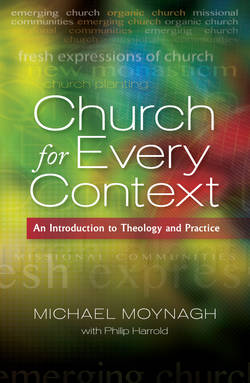Читать книгу Church for Every Context - Michael Moynagh - Страница 24
На сайте Литреса книга снята с продажи.
Saint Paul’s New Contextual Churches
ОглавлениеEvangelical critics of the emerging church conversation, such as D. A. Carson (2005), frequently complain that participants are not biblical enough; in their eagerness to connect with contemporary culture, contributors tend to lose their scriptural moorings. Critics from the more Catholic end of the spectrum, such as Andrew Davison and Alison Milbank (2010), accuse fresh expressions of church (and no doubt would include the emerging church conversation) of paying insufficient attention to the church’s tradition.
To help ensure that Church for Every Context is rooted in Scripture and has a strong eye to the tradition, Part 1 begins with a discussion of Saint Paul’s approach to church planting. Chapter 2 provides some historical precedents for contextual church. Chapter 3 recounts Britain’s recent experience of fresh expressions of church, while Chapter 4 puts these developments into a sociological perspective. The purpose of these chapters is to place new contextual churches in their historical and contemporary setting, and to show that church reproduction is intrinsic to the church’s missional life.
Starting with Saint Paul is no accident. He is widely regarded as one of history’s most fruitful church pioneers. So it is natural to ask what his experience can teach us. Eckhard Schnabel (2008) has recently provided a comprehensive description of Paul’s approach to mission, while Loveday Alexander (2008), James Dunn (2008), Richard Bauckham (2011) and John Drane (2011) have used New Testament material to reflect on fresh expressions of church and church pioneering.
In following them to learn from the New Testament, we must tread with care. Not all scholars accept the historical accuracy of Acts for example, although plausible reasons exist for assuming that Luke provides a faithful account (Hengel, 1979; Hemer, 1989). We must allow for differences between the New Testament and contemporary worlds, and we must avoid jumping from the New Testament to now as if the church has done no reflection in between.
Discerning in the light of the whole biblical story which actions within the narrative might serve as examples for today is a delicate task. We must also keep in mind that Paul was not the only apostle to found new churches – we just know more about him. Finally, it would be a mistake to plunge straight into Saint Paul’s missionary journeys. If we wind back a little, we shall find lessons from an earlier period.
So, we shall look at the shift in emphasis from a ‘come’ to a ‘go’ approach to mission, explore lessons for the ‘mixed economy’ (old and new churches living alongside each other in a denomination), discuss Paul’s pioneering teams, speculate a little on some of the processes involved in bringing Paul’s churches to birth, consider how far Paul’s new congregations were culture specific and examine his transition of leadership.
